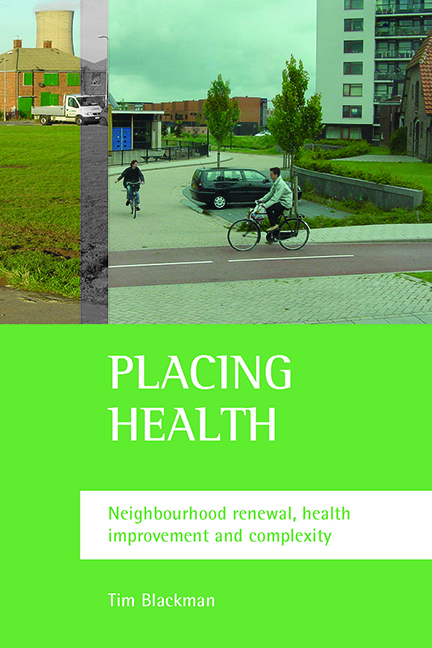Book contents
- Frontmatter
- Dedication
- Contents
- List of tables and figures
- Acknowledgements
- List of abbreviations
- Preface
- one Policy and places
- two Health, neighbourhoods and complexity
- three Emergence and environment press
- four The neighbourhood effect
- five Neighbourhood renewal and health inequalities
- six Health inequality as a policy priority
- seven Conclusion: neighbourhoods in the wider picture
- References
- Index
- Also available from The Policy Press
- Frontmatter
- Dedication
- Contents
- List of tables and figures
- Acknowledgements
- List of abbreviations
- Preface
- one Policy and places
- two Health, neighbourhoods and complexity
- three Emergence and environment press
- four The neighbourhood effect
- five Neighbourhood renewal and health inequalities
- six Health inequality as a policy priority
- seven Conclusion: neighbourhoods in the wider picture
- References
- Index
- Also available from The Policy Press
Summary
To care for places, and to realise the potential of people, are intrinsically good things to do. This book is an investigation of how well we are doing them when it comes to renewing disadvantaged neighbourhoods and reducing preventable causes of illness and death. By renewing neighbourhoods it is possible to tackle inequalities in health that have something to do with where people live. With the arrival in 2001 of England's National Strategy for Neighbourhood Renewal we can investigate whether this possibility is starting to be realised, given that this marked ‘a much firmer statement of the desirability of a more spatially equal society than governments have ever voiced before’ (Kintrea and Morgan, 2005, p 13). If, as Marmot (2004, p 9) remarks, ‘health can be used as a marker of a successful society’, then health outcomes across society are both an object of, and a judgement on, such a strategy.
Neighbourhood renewal and tackling health inequalities are interventions in ‘wicked problems’; issues that are ‘hard to treat’ not just because they are complicated but because they are complex. In the audit culture of contemporary public policy, the delivery of programmes to tackle these issues is performance managed. This needs to embrace the whole system in which the issues are embedded and assess how far inequality gaps are closing. The major test of these programmes is whether they improve conditions in the most disadvantaged areas at a faster rate than conditions improve for the population as a whole. These challenges of auditing change in whole systems and narrowing gaps as measured by ‘floor targets’ present a research agenda that currently is catching up with policy innovation rather than leading it.
As chapters in the book argue, complexity theory offers a conceptual framework for making more progress on this research front. The theory is worth serious attention among social scientists and policy makers, and in some quarters is getting it. Complexity is ‘out there’ as a real phenomenon and there is something extraordinary about the apparent growth of complexity across time as if ‘built into the structure of the world’ (Gregersen, 2003, p 228). For a while it was Ragin's (2000) book on Qualitative Comparative Analysis (QCA) that gave me a framework for moving on from complexity theory to actual empirical and policy implications, and Ragin remains a big influence.
- Type
- Chapter
- Information
- Placing HealthNeighbourhood Renewal, Health Improvement and Complexity, pp. xi - xivPublisher: Bristol University PressPrint publication year: 2006



